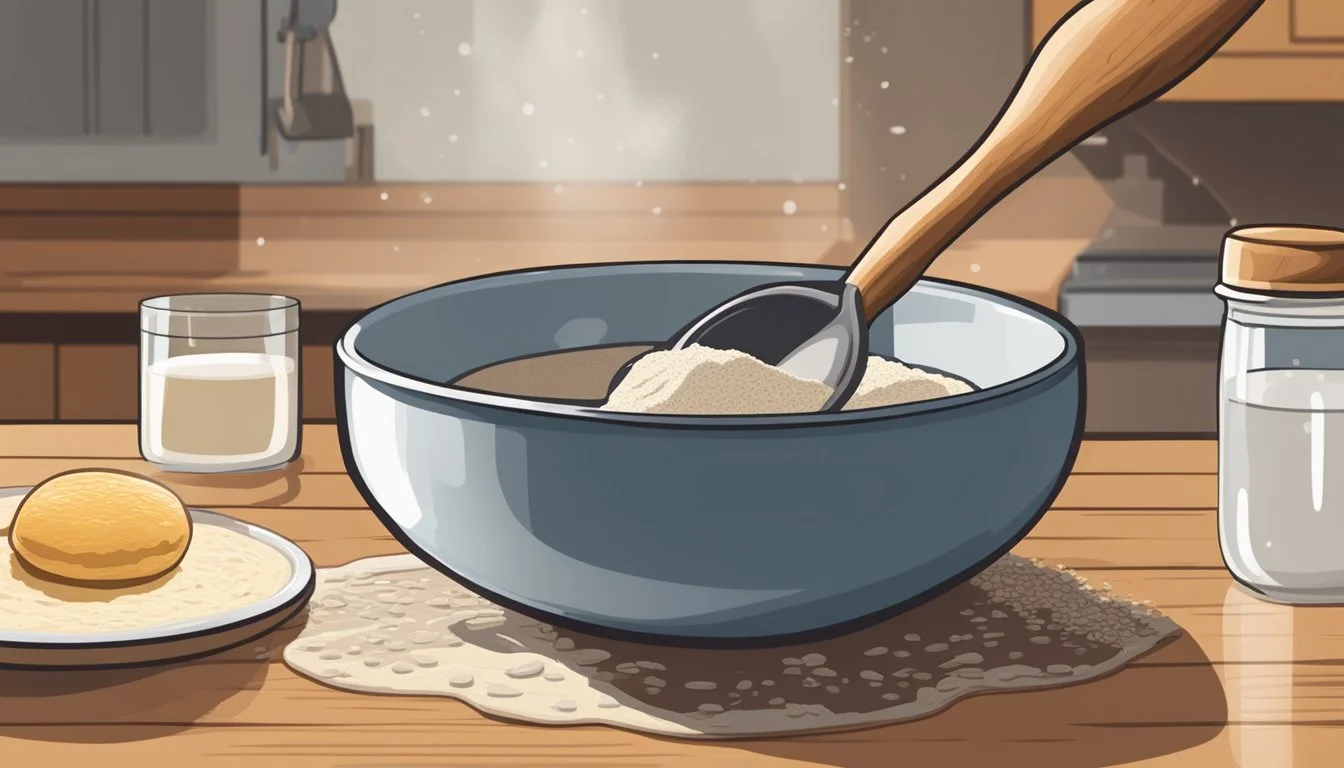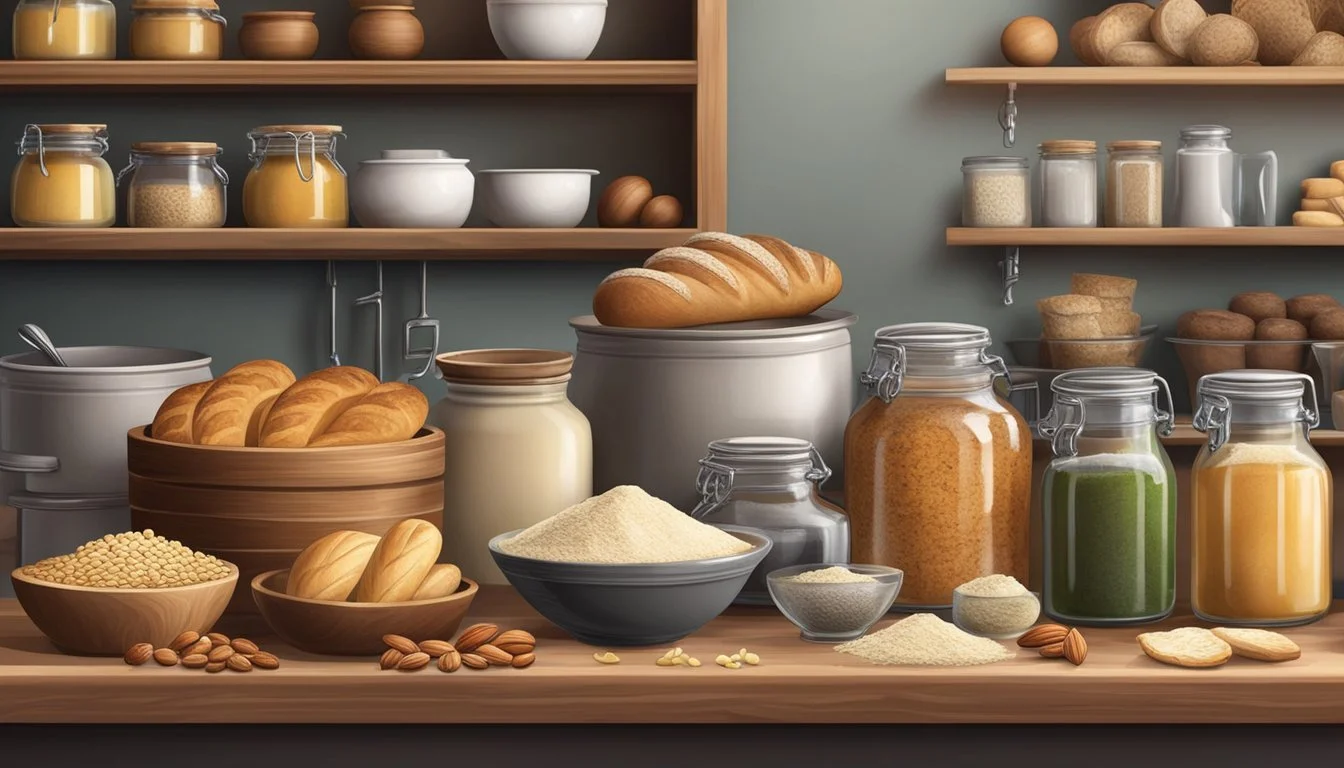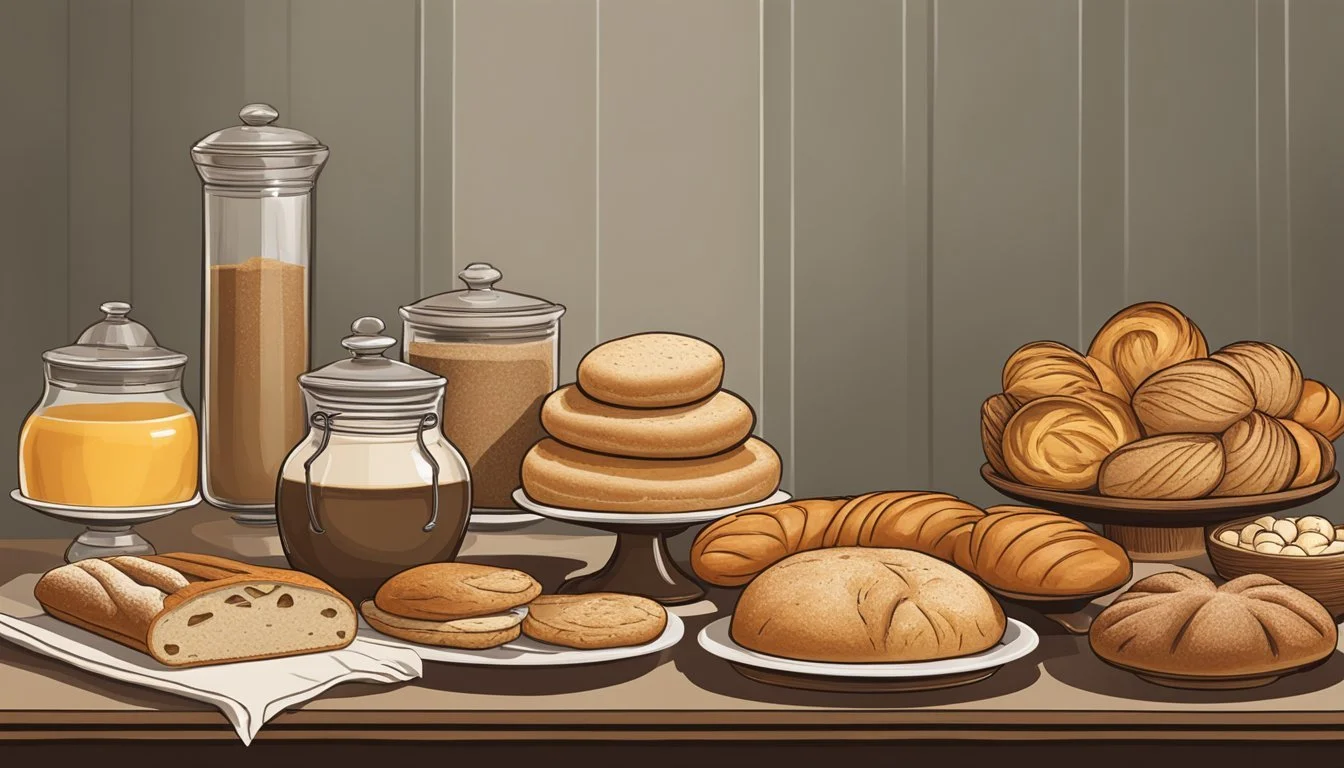How to Cook with Spelt Flour in Breads and Pastries
Mastering Whole Grain Baking
Spelt flour, hailing from an ancient grain, has become increasingly popular among health-conscious individuals and those seeking to diversify their baking ingredients. As a precursor to modern wheat, spelt offers a slightly nutty flavor and a more complex nutritional profile, making it an appealing alternative to more conventional flours. Its reemergence in the culinary world aligns with a growing trend towards whole foods and a push for variety in the grains we consume.
When it comes to baking, spelt flour can be a game-changer, especially for those looking to infuse a new dynamic into breads (What wine goes well with bread?) and pastries. The flour is versatile and can often be used as a substitute for all-purpose flour, though the ratio and hydration levels might need slight adjustments. Its gluten structure is more delicate, which lends itself to producing tender baked goods, but also requires a careful hand during the kneading process to avoid overworking the dough.
Navigating the nuances of using spelt flour in the kitchen is essential for achieving the best results. Bakers will find that while it absorbs water differently, it enriches recipes with depth of flavor and nutritional benefits, including higher protein and fiber content. Mastery of spelt flour opens up a world of possibilities for crafting wholesome and delicious breads and pastries that stand out for both their unique taste and healthful qualities.
Understanding Spelt Flour
Spelt flour, an ancient grain revered for its nutritional benefits, offers an alternative to modern wheat varieties. Its profile includes a rich array of vitamins, minerals, and fibers, making it a popular choice among health-conscious consumers.
Origins and History
Spelt is one of the oldest cultivated grains, with its use dating back to approximately 5,000 BCE. Initially grown in Iran and parts of Europe, this ancient grain was a staple in diets due to its hardiness and ability to thrive in poor soil conditions. Spelt's popularity dwindled with the rise of modern wheat varieties, but it has seen a resurgence as consumers search for more nutrient-rich options.
Nutritional Profile
Nutritionally, spelt flour is a powerhouse. It is high in protein and fiber, which are vital for maintaining bodily functions and digestion. Spelt provides essential nutrients, including vitamins like niacin and thiamin, and an impressive array of minerals, such as iron, magnesium, phosphorus, potassium, and zinc. It's particularly well-regarded for its whole grain properties.
Comparing Spelt to Modern Wheat
Spelt and modern wheat diverge in several respects. While both contain gluten, spelt gluten is more water-soluble, making it easier to digest for some people. Spelt offers a broader nutrient spectrum than common whole wheat flour. It often boasts higher protein content, and although it's not gluten-free, its gluten structure makes it more tolerable for individuals with sensitivities to modern wheat variants.
Spelt Flour Variants
There are essentially three variants of spelt flour:
White Spelt Flour: Milled similarly to all-purpose flour with the bran and germ removed, resulting in a lighter texture suitable for pastries.
Whole Grain Spelt Flour: Contains the germ and bran, which makes it denser but richer in nutrients.
Sprouted Spelt Flour: Made from grains that are sprouted before milling, enhancing digestibility and bioavailability of nutrients.
Preparing Spelt Flour for Baking
Before incorporating spelt flour into baking, one must consider optimal storage, blending with other flours, and proper hydration techniques to achieve the best results.
Storing Spelt Flour Effectively
Spelt flour, known for its nutty flavor and wholesome nutrition, should be stored with care to maintain its freshness. To preserve the flour's quality, it is essential to keep it in airtight containers. This prevents moisture, air, and pests from compromising the flour's integrity. Proper storage extends the shelf life and ensures the flour retains its unique taste. Store spelt flour in a cool, dry place away from direct sunlight to prevent any excess moisture buildup that could affect its texture.
Mixing Spelt Flour with Other Flours
Blending spelt flour with other flours like all-purpose flour or whole-wheat flour can create a desired balance in baked goods, since spelt is lower in gluten compared to traditional wheat flours. This combination can provide the structure needed for bread and pastries. If seeking a gluten-free alternative, spelt flour isn't suitable as it does contain gluten. For gluten-rich recipes, a small amount of vital wheat gluten may be added to reinforce the strength of the dough.
Hydration and Kneading Techniques
Spelt flour's absorption of moisture differs from that of other flours. As such, recipes might require adjusting the hydration levels. When preparing dough with spelt flour, one should start with less liquid and gradually increase as needed. During the kneading process, a lighter touch is preferable because over-kneading can lead to a heavy and dense texture. Spelt dough generally requires less kneading compared to other wheat dough, which results in a tender crumb for your breads and pastries.
Baking with Spelt Flour
Baking with spelt flour introduces a nuttier, complex flavor to breads and pastries. It requires attention to detail in recipe adjustments, fermentation practices, and baking parameters to ensure a successful bake.
Adjusting Recipes for Spelt Flour
When one substitutes spelt flour in a recipe, the key is to consider the flour's ability to absorb liquid. Generally, spelt flour requires less hydration than all-purpose flour.
Standard Conversion: Use approximately 3/4 cup of spelt flour for every 1 cup of all-purpose flour recommended.
Hydration: Begin by reducing the liquid by 10-15%, then adjust as necessary, looking for a dough that is tacky but not overly sticky.
Rise and Fermentation Tips
Spelt flour behaves differently than all-purpose flour during fermentation due to its lower gluten content, leading to a delicate structure.
Yeast Quantity: Spelt bread doughs require slightly less yeast; too much can cause overproofing because spelt rises faster than traditional flour.
First Rise: Allow the dough to rise until just doubled - it usually takes less time than wheat flour doughs.
Proofing: Watch bread closely as it proofs. Overproofed spelt dough will collapse and result in a dense loaf.
Oven Temperatures and Baking Times
Spelt flour's lower gluten content demands careful attention to oven temperatures and baking times.
Preheating: Always preheat the oven to assure even cooking. The recommended temperature may vary, but a good starting point is between 350°F to 375°F (177°C to 190°C).
Bake Time: These may be shorter compared to wheat flour baked goods. Check for doneness earlier than the recipe suggests to avoid overbaking.
Specific Spelt-Based Recipes
When incorporating spelt into recipes, one can confidently experiment with a range of baked goods, from traditional breads to sweet pastries and beyond. Spelt flour adds a nutty and slightly sweet flavor profile that enhances the taste of various recipes. It also offers a more easily digestible gluten structure, suitable for those with sensitivities, though not for individuals with celiac disease since it still contains gluten.
Breads
Spelt Bread: Bread enthusiasts can enjoy the wholesome goodness of a homemade spelt loaf. A basic spelt bread recipe typically involves a straightforward mix of spelt flour, yeast, water, a touch of sweetener, and salt. For example, an Effortless Rustic Bread can be baked to perfection in a Dutch oven, providing a crispy crust and tender crumb.
Challah: Challah made with spelt flour results in a delicately sweet and rich bread, perfect for special occasions. Bakers should handle the dough with care to maintain its soft texture.
Pastries and Desserts
Muffins: Spelt flour can be substituted into most muffin recipes to add a nutritious twist.
Pie Crust: Use white spelt flour for a flaky, golden pie crust that works well with both sweet and savory fillings.
Brownies & Chocolate Chip Cookies: Delicious desserts like brownies and spelt chocolate chip cookies, with their deep flavors complemented by spelt's nuttiness, can satisfy any sweet tooth. Spelt cookies are another delightful treat, offering a more wholesome take on classic desserts.
Other Baked Goods
Crackers: For a healthy snack, spelt crackers can be a crunchy alternative.
Cakes & Pancakes: Spelt flour's versatility shines in cakes, giving a dense, moist texture, and in pancakes, for a nutritious breakfast option.
Pizza Crust: A spelt flour pizza crust delivers a rustic and hearty base for all favorite toppings.
Vegan and Gluten-Sensitivity Options
Spelt flour is not gluten-free, hence unsuitable for individuals with celiac disease. However, those with mild gluten sensitivities may find spelt-based baked goods easier on the digestive system. Vegan bakers can also incorporate spelt flour into their recipes, pairing it with plant-based ingredients to craft everything from spelt biscuits to vegan spelt loaf variations. Always ensure to check individual dietary needs before choosing spelt as an alternative flour.
Creative Uses of Spelt Flour Beyond Baking
Spelt flour is versatile enough to step out of the bakery and into other culinary areas. Its hearty texture and slight nuttiness lend well to more savory applications, offering a nutritious twist to traditional dishes.
Homemade Pasta and Noodles
Consumers can craft nutritious pasta and noodles with spelt flour. It imparts a desirable chewiness and a deeper flavor profile compared to regular pasta. To create spelt pasta dough, they simply mix the flour with eggs and a pinch of salt before kneading and shaping.
Thickening Agent for Soups and Sauces
Spelt flour can serve as an effective thickener in soups and sauces. It is particularly useful for those looking to incorporate wholesome, unrefined grains into their diet. When using spelt flour, individuals should incorporate it gradually to prevent clumping and achieve a smooth consistency.
Coating for Fried Foods
As a coating for fried foods (What wine goes well with fried foods?), spelt flour contributes a crispy texture and a burst of flavor. Chefs often recommend a light dredging in spelt flour to enhance the dish's aesthetic and taste. It works well with a variety of foods, including chicken, fish, and vegetables.
Health and Dietary Considerations
When incorporating spelt flour into breads and pastries, it is important for individuals to consider its digestibility, potential allergy concerns, and its role within a balanced diet. Spelt flour is often praised for its wholesome nutrition, including being a good source of dietary fiber and certain B vitamins.
Digestibility and Allergies
Spelt flour is known for its high fiber content, which can aid in digestion. Dietary fiber is essential for a healthy digestive system, and incorporating whole grain spelt can contribute to the recommended daily intake. However, it's important to note that spelt is a form of wheat and contains gluten. It may be easier to digest for some people compared to common wheat, but it is not suitable for those with celiac disease or a gluten intolerance.
Incorporating Spelt into a Balanced Diet
Including spelt flour in one's diet can add nutritional value due to its profile of B vitamins and minerals. Spelt is a nutritious whole grain that offers a range of health benefits. Here's how it can fit into a balanced diet:
Whole Grain: As a whole grain, spelt retains all parts of the grain kernel, including the bran, germ, and endosperm, ensuring a dense nutritional content.
B Vitamins: Spelt flour is a good source of B vitamins, essential for energy metabolism and maintaining good health.
Balanced Diet Contribution:
Part of Grains Group: Spelt flour can be a part of the daily grains intake, especially within a diet that emphasizes whole grains.
Moderation is Key: While spelt flour is nutritious, it should be consumed in moderation along with a variety of other foods to ensure a balanced intake of nutrients.
By considering these aspects, one can make informed decisions on how to successfully include spelt flour within their culinary repertoire while being mindful of their overall health and dietary needs.
Tips for Sourcing and Milling Spelt
Spelt flour can elevate breads and pastries with its nutty flavor and wholesome nutrition. Proper sourcing of the grain and effective home milling techniques can significantly influence the quality of the end product.
Choosing High-Quality Spelt Grain
Consumers should prioritize organic spelt grains to ensure they are getting a product that is free from synthetic pesticides and fertilizers. Organic grains are known for their practices that emphasize soil health and environmental responsibility. When selecting spelt, freshness is paramount; the grain should have a pleasant, slightly sweet odor and be free from any signs of moisture or pest damage.
Visual Inspection: Look for uniformity in color and size.
Smell: Fresh spelt should have a slightly sweet, earthy aroma.
Certification: Seek out brands that carry reputable organic certifications.
Using a Grain Mill at Home
Milling spelt at home gives bakers control over the fineness of their flour, which can affect the texture of baked goods. A home grain mill, manual or electric, can be used for this process, and it's an investment for those committed to baking with freshly milled spelt flour.
Grain Mill Settings: Adjust the mill to fine for a lighter texture in cakes and pastries, or to coarse for hearty bread.
Temperature: Ensure that grains remain cool during milling to preserve flavor and nutrients.
Storage: Freshly milled spelt flour should be stored in a cool, dry place or refrigerated to extend its shelf life.
Culinary Inspirations and Food Pairings
Spelt flour’s unique nutty flavor lends itself to a range of culinary pairings, enhancing the taste of breads and pastries. The rich and complex taste of spelt flour can be further enriched when combined with the right ingredients.
Infusing Flavors with Herbs and Nuts
Incorporating herbs and nuts into spelt flour recipes can significantly elevate the final product’s flavor profile. For example, rosemary or thyme can infuse aromatic undertones to spelt bread, complementing its earthiness.
Nuts: Walnuts or pecans, when added, enhance the nutty notes of spelt.
Herbs: Choose rosemary, thyme, or sage for savory baked goods.
Matching Spelt Flavors with Other Ingredients
To harmonize with spelt flour's intrinsic tastes, one should select ingredients that balance or complement its distinctiveness.
Oils and Sweeteners: Olive oil provides a fruity undertone while honey adds a mellow sweetness.
Dairy: Incorporate eggs or butter for richness and a tender crumb.
A thoughtful combination of these elements can result in pastries and breads that are not only flavorful but also possess a satisfying texture.
Cultural Significance and Regional Variations
Spelt has a storied history, with particular prominence in European culinary traditions where it's been used for centuries. In modern cooking, it continues to influence breads and pastries within various regions, often seen in the adaptation of traditional recipes.
Spelt in European Cuisines
In Germany and Switzerland, spelt (Dinkel in German) holds a significant cultural heritage, particularly in regions like Swabia and Bavaria. It is integral to countless traditional recipes. German kitchens frequently employ spelt flour in the creation of rustic breads and delicate pastries. One famous example is the German Dinkelbrot, a spelt bread that personifies the heartiness attributable to spelt's use in German baking.
Switzerland boasts its own spelt-based specialties, such as Bündner Nusstorte, a nut-filled pastry with a spelt flour crust often savored during celebratory occasions. Spelt’s nutty flavor and versatility make it a cherished grain, honoring tradition while also satisfying contemporary tastes.
Signature Spelt Foods in Germany and Switzerland:
Germany: Dinkelbrot, Spelt Pretzels
Switzerland: Bündner Nusstorte, Spelt Zopf (a type of braided bread)
Adapting Traditional Recipes with Spelt
Chefs and home cooks often seek to incorporate spelt flour into their recipes due to its nutritional benefits and distinct taste. It is common to see spelt as a replacement for all-purpose or whole wheat flour in traditional recipes, adjusting to suit the distinctive absorption properties and gluten content of spelt.
To successfully adapt a recipe, incremental substitution is key, starting with replacing about one-quarter of the regular flour with spelt and observing the changes in dough consistency and texture. Here are some tips for adapting recipes:
Begin with replacing 25% of the regular flour with spelt flour.
Adjust the liquid content if necessary, as spelt can absorb more moisture.
Knead doughs containing spelt less than when using traditional wheat flour to prevent them from becoming tough.
Utilizing spelt flour can revive an age-old recipe, infusing it with a unique flavor that respects its origins while presenting it anew to the discerning palates of modern-day connoisseurs.





